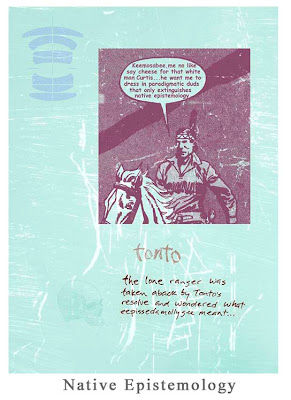 Part Three, McNeil Art in "Identity Exhibition"
Part Three, McNeil Art in "Identity Exhibition"
My own art for this Identity exhibition consists of three hand-made lithographs. These three lithographs are closely related with both their visual aesthetic and the idea that drives them. In my case, the idea that drives them has to do with how ravens can't help but poke fun at the world. What the heck, it just happens. I was very fortunate to work with Master Lithography printers from both the Tamarind Art Institute and the Crow's Shadow Art Institute with both of these projects. The prints are:
- Diacritical Formline, Chilkat Style
- Native Epistemology
- Edward Curtis' Last Photograph
I've written an artist's statement specifically for these three lithographs. The "Native Epistemology" and "Edward Curtis' Last Photograph" lithos were made in conjunction with the "Migrations, New Directions in Native American Art" project, and the "Diacritical Formline, Chilkat Style" print was made with Frank Janzen at Crow's Shadow Press (whom is having a very cool fund-raising Monothon next month, by the way)
Identity, Humanity & Mythologies
(artist's statement)
Lately I’ve been doing a bit of sifting, trying to figure out not only American identity, but also the broader notion of human identity, whatever that means. For an example, I found myself continuing to ask why humans remain so enamored with myths, a very clear retro holdover from ancient times. It seems that we just can’t help ourselves when it comes to using myths.My own theory about myths has to do with humans being pack animals, which means that for better or worse, we’re linked together and there is definitely a top dog and hierarchy to our group. It was clear that in order to survive and evolve together, we also had to have rules that drove how we interacted with each other. I would be willing to bet that humans created mythological stories soon after developing a rudimentary language, and that these myths had to do with keeping order in the pack and having a group act as one; that the myths were powerful stories about morals and served as a kind of behavioral guide for members to follow. Are humans hard wired for myths?
I’ll jump ahead to our own American mythological stories, which have cowboys running around wild as rugged individualists, rebelling against the idea of being a member of the pack and doing things their way. They wore the proverbial white hats and seemingly wrestled the frontier into submission. This cowboy mythology set the stage for industrialists to follow and anyone else in creation that wanted to dance to their tune. The only problem with this mythological story was that it was flawed from the beginning, which is what my own art is about. I must say that I have fun with the American mythology and in the spirit of Raven, our own Northwest Coast mythological being, change things around. Raven has stories that are full of irony, humor and moral righteousness. He can be a scoundrel and still be good, because his acts are ultimately moral, even if he does break the rules along the way. In this sense, the essence of my art is very ancient, because it continues our myths; they live on at the start of the 21st century.
The lithograph Diacritical Formline, Chilkat Style is about the philosophy that drives the Northwest Coast formline. Oops, I forgot to use formlines. Oh well, so what. It has to do with Tlingit attitudes, including that of being a warrior race who drove out successive waves of foreign colonialists; first the Russians, then the English. Have you ever wondered why Southeast Alaska does not belong to Canada? Tlingits! Anyway, our good friend Edward Curtis made some photos that had to do with vanishing Indians (screw that!), so in the spirit of my ancestors, I simply take his twisted ideas and turn them around for our own purposes. I have an indigenous family out for a family cruise on the floor of Canyon De Chelly, instead of the romanticized idea of noble savages riding their horses everywhere (If you look closely, you can see Yéil, raven).
Native Epistemology and Edward Curtis’s Last Photograph were made simultaneously and have Tonto being transformed into an indigenous intellectual putting Curtis on notice that not only was his premise for his entire body of work wrong, but his ass is about to be kicked by some very put out Tlingit warriors. This still makes me laugh, and what makes it really sweet is that there is an historical truth to the lithographs too. Curtis never did make any significant photographs in Tlingit country, because of what likely happened in the Edward Curtis’ Last Photograph lithograph. Raven lives on, and I must say, he’s still having fun.
Larry McNeil, Xhe Dhé, Keet Gooshi Hít, Klukwan Chilkat
Tlingit Artist & Scholar





No comments:
Post a Comment